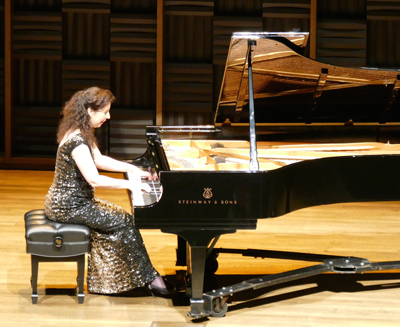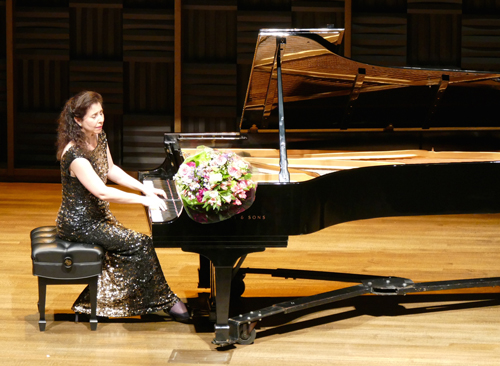by Daniel Hathaway

The nearly full house was a testament to Hewitt’s reputation. Her recital of music by J.S. Bach, Beethoven, Domenico Scarlatti, Albéniz and Liszt affirmed her status as a thrilling, clear-headed artist whose playing is so healthy and natural that it should be labeled “100% organic.”
The music of Johann Sebastian Bach is a Hewitt specialty, and her strong, insightful playing of the G-major Partita got the program off to a fine start. She made a brilliant toccata out of the “Praeambulum,” and her “Allemande” ambled along as playfully as the following “Courante” dashed to the finish line. She infused the “Sarabande” with a delightful French languor, and tossed the “Minuetto” and “Passepied” off with spirit. The “Gigue,” festive but neatly controlled, ended the partita stylishly.
Beethoven’s next-to-last sonata, No. 31 in A-flat, sounded fresh and improvisatory in Hewitt’s hands — she acted as though she might be experiencing some of the composer’s quirky changes of direction for the first time. Following the petulant “Scherzo” with a muted, measured “Adagio,” Hewitt let the fugue take her away down curious avenues where Beethoven interrupted the counterpoint with an aria, then with a wall of successively louder repeated chords that led to a resumption of counterpoint, and eventually to an exultant, almost steely ending.
Many pianists use Domenico Scarlatti’s sonatas as warm-ups at the beginning of recitals, but Hewitt chose four of them to change things up after intermission. That proved to be an interesting and effective position for these continuously inventive pieces (there are 555 of them). A two-part invention, fanfares, and a legato arioso preceded No. 29, a flashy perpetual motion exercise that called for some daring cross-hand work, first with single notes, then with triads. Through all those complicated passages, Hewitt didn’t nick a key.
Three evocative cityscapes from Isaac Albéniz’s Suite Española followed and extended the Spanish theme (Scarlatti was Italian, but spent most of his career in Spain). “Sevilla” featured elegant octaves, “Asturias” strumming guitars. “Castilia” brought the mini-suite to a colorful conclusion with a thrilling Iberian toccata (amid some dramatic arm choreography from Hewitt).
The recital might happily have ended with that sunny music, but Angela Hewitt opted for dark drama, taking us on a descent into the Inferno with Liszt’s Aprés une Lecture du Dante: Fantasia quasi Sonata. Though Liszt, as a minor cleric, had some stock in making sure that redemption was part of the narrative of this piece, it becomes more exciting when the powers of hell get the upper hand. Hewitt conjured up a controlled but tumultuous scene that showed she still had formidable reserves of energy and virtuosity left at the end of a long program.
After CIPC’s Pierre van der Westhuizen pressed a huge bouquet into her hands, Angela Hewitt sent a delighted audience home with a gentle encore, “her favorite” Scarlatti sonata, the one in E-Major.
Photos courtesy of Cleveland International Piano Competition.
Published on ClevelandClassical.com November 18, 2014.
Click here for a printable copy of this article




